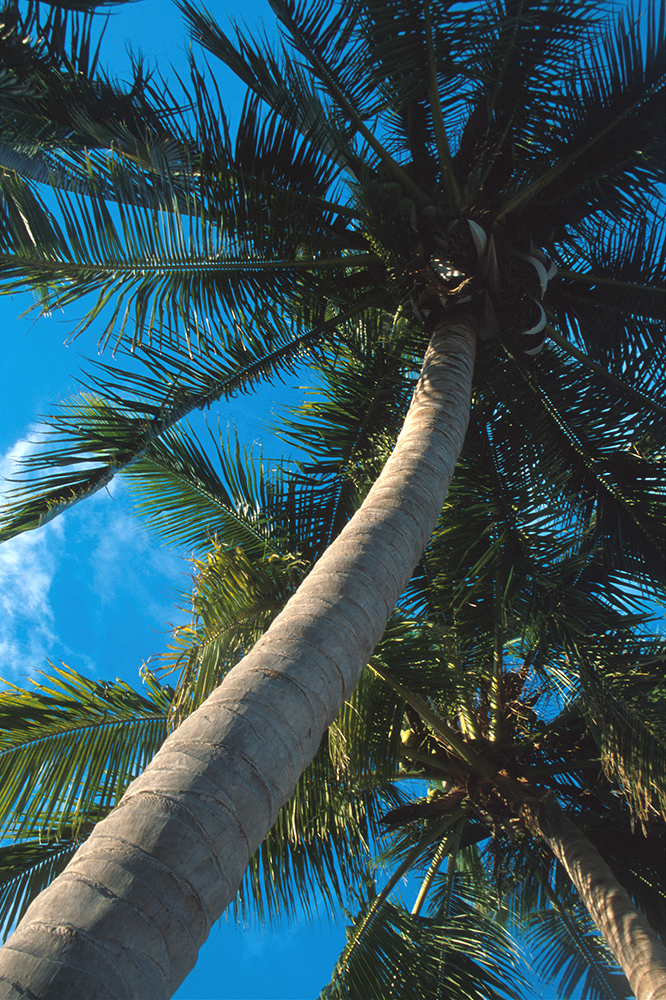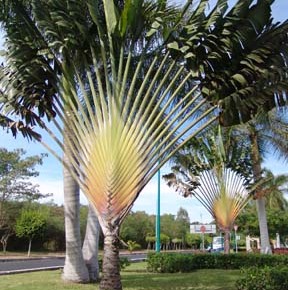 They are the standard of vacation, the flags of beachy climes. Their shape makes them one of the most easily identified plants in the world. Palms belong to the Arecacea (Palmae) family, order Arecales. There are more than two thousand species, most of which are native to tropical and subtropical climates. The widely recognized growth -a single stem with compound foliage- is common in the palm family, although there are those with creeping or branching habits. The leaves are generally palmately (the fan palms) or pinnately (feather frond) shaped, although some are classified as costapalmate, meaning somewhere between the two, and still others have entire leaves. Most palms produce drupes, a fruiting body with a fleshy outer layer covering a hard inner layer, inside of which is the seed. Think of a coconut off the tree, its thick green husk (exocarp), the shell or endocarp, and then the white meat (seed).
They are the standard of vacation, the flags of beachy climes. Their shape makes them one of the most easily identified plants in the world. Palms belong to the Arecacea (Palmae) family, order Arecales. There are more than two thousand species, most of which are native to tropical and subtropical climates. The widely recognized growth -a single stem with compound foliage- is common in the palm family, although there are those with creeping or branching habits. The leaves are generally palmately (the fan palms) or pinnately (feather frond) shaped, although some are classified as costapalmate, meaning somewhere between the two, and still others have entire leaves. Most palms produce drupes, a fruiting body with a fleshy outer layer covering a hard inner layer, inside of which is the seed. Think of a coconut off the tree, its thick green husk (exocarp), the shell or endocarp, and then the white meat (seed).
Aside from their attractive foliage, palms provide products from raffia to dates. Among the many utilitarian varieties are the oil palm (Elaeis); the acai palm (Euterpe), which yields both hearts of palm and an edible drupe often used in drinks; and Jubaea, the Chilean wine palm. Palms furnish the rattan for furniture (Calamus) and carnauba wax (Copernicia), used in everything from cosmetics to car polish.
Of course, many species of palm are grown purely for their ornamental value. Because they don’t mind being squeezed a little at the roots, palms take very well to container gardening, often happily spending two or three years in the same pot. Species whose mature height wouldn’t fit beneath a roof can still be displayed in interiors, as the contained environment tends to slow growth. For example, the princess palm can grow up to 30 feet, but makes a pretty potted plant when young.In addition to being good indoor specimens, palms are a favorite of landscapers. Their dramatic nature and association with the tropics has made them popular worldwide. Many are native to Mexico, including the Guadalupe palm (Brahea edulis), Palma Dulce (B. dulcis), and Mexican Washingtonia (W. robusta).Palmettos or sabal palms, also known as cabbage palms, are a great landscaping plant, the taller varieties bearing the classic palm shape, and smaller ones making nice tropical shrubs. There are many Sabals endemic to Mexico, including Cana Rata (S. yapa), Palma de Vaca (S. mauritiiformis), and Sonoran palmetto (S. uresana). Sabal palms are one of the genera harvested for their hearts, and the saw palmetto, Sabal serrulata, has been used in the treatment of baldness, bladder and prostate conditions.
Hurricane palms (Dictyosperma), also known as princess palms, are named for their alleged ability to withstand hurricane force winds. They are self-cleaning, which is a nice feature in a landscaping plant, and have a slender, single-trunk 20-25 feet habit. The slightly swollen crownshaft is topped with elegant, symmetrical, pinnate fronds. Different varieties boast reddish new foliage or dark grey trunks; all provide a lush tropical look.Areca or butterfly palms are native to the tropical islands of Southeast Asia. As their common name implies, they are graceful, fluttering plants with a clumping habit, growing to around 20 feet tall. The slender yellow stems support arching green pinnate leaves. They grow outdoors in tropical and subtropical regions, and do well for years as potted plants. Some of the Chamaedorea species (Mexican natives C. tepejilote, C. hooperiana) have a similar shape; that of a Victorian parlor palm.Other Chamaedorea boast entire leaves, or heart shaped fronds. C. tuerckheimii, the potato chip palm, is round and ridged like a Ruffle ™. There are a number of shade-loving understory species within this genera, all of which make good tropical garden filler or container plants.A darling plant, the pygmy date palm (Phoenix roebelenii) grows to 10-15 feet, although it will remain smaller (6-7 feet) if kept in a container. They are good potted specimens, offering a recognizable palm shape with thin, shiny green pinnate fronds. The trunk stem bears the spikes characteristic of date palms.
Among the most unusual Arecacea, fishtail palms (Caryota) have a bipinnate structure whose leaflets indeed resemble fishtails in their triangular shape, veining, and jagged edge. There are both single trunk and clumping varieties, and they tend to be speedy growers. Caryota are monocarpic, which means they die after flowering, although the floral process can last for years as mop-head clusters of flowers slowly descend the trunk until they reach the ground.From dwarf varieties to 80 feet tall giants, somewhere in the 200+ genera of palms there is one for everyone. New red feathery foliage, leaves of metallic sheen, blue-green fans, yellow, grey, or snakeskin-banded trunks; a plethora of finishes and textures. An entire garden could be built from the palm family, using different varieties as canopy and understory plants, but a single trunk stunner or specimen stand is enough to lend that tropical feeling to any setting.
- A Sabal species
- Adonidia merrillii, formerly known as Veitchia merrillii
- areca_catechu_(golden)_fowlers
- butia_capitata_palmetto
- chamaedorea_tepejilote_(seeds)
- chamaedorea_tepijilote
- Cocos nucifera
- Cocos nucifera
- Cycas revoluta, the Sago Palm, cycad
- Cycas revoluta
- dictyosperma_hurricane palm
- Dypsis lutescens
- Dypsis lutescens
- phoenix_roebelenii_pgmy date
- phoenix_roebelenii_pgmy date palm
- Ravanala-madagascarensis-Traveler-Palm
- Roystonea-regia-Royal-Palms
- sabal_palmetto
- washingtonia_robusta_left_washingtonia_filifera_right
- washingtonia_robusta







































